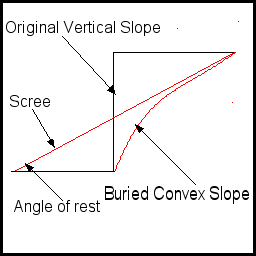Flattening of a slope by weathering and mass action.
Please start at Evolution.html
This is the simplest of all forms of slope evolution.
Conditions:
(a) An initial vertical or steep slope.
(b) Mechanically strong rock that can support a vertical slope.
(c) No agent of erosion at the base of the initial slope.
(d) Mechanical weathering of the rock face.
(e) Detatchment and free fall of the weathered fragments.
(f) The weathered fragments accumulate at the base of the initial slope and are not removed.
(g) The weathered fragments stand at their angle of rest.
This type of slope evolution will occur where a sea cliff is no longer subject to marine erosion due to the formation of a natural or man-made barrier in front of it.
Explanation of the simulation:
(a) Solid rock is shown in green. It is divided up into rectangles that represent the size of fragments that it will weather to.
(b) The weathered fragments are shown in yellow.
(c) The angle of rest in the model will be determined by the dimensions of the rectangle. If the rectangles are piled up as shown in the simulation the angle of rest is given by the diagonal of the rectangle. So the diagonal of a square will give an angle of rest of 45 degrees.
The dimensions of the rectangles can be selected to give what ever angle of rest is required.
(d) Each click for the manually operated simulation represents a set interval of time.
The end result of this type of slope evolution is shown in the diagram below.

|
